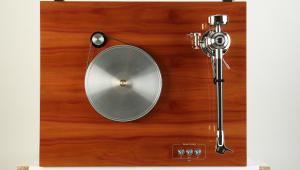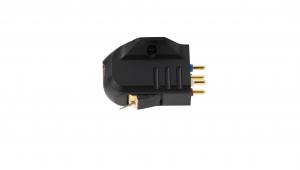Amazon 2/morch Dp 6 (£3700)
Elegantly armed by a Danish ally, this German turntable has a classy look. But with current exchange rates, can the Amazon find a competitive place in today's TT jungle?
Strange as it may seem now, in the early 1990s there was a period when you could go for months without seeing a vinyl-playing product reviewed in Hi-Fi News. Here in the UK, at that time, there just weren’t any new turntables to review.
In Germany, though, things were different. Every time we visited the High End Show, which was then held every year in Frankfurt, we would see more turntables than you could shake a tonearm wand at, not just new turntable models, but enthusiastic new turntable manufacturers. One of those makers was Amazon, based just up the road at Oberursel.
Founder and designer Hartmut Janssen produced the first Amazon turntable in 1986, introducing the idea of a subchassis decoupled by LRP (low resilience polymer) elements rather than metal springs.
In his original Amazon Reference model, Janssen also pioneered the use of a DC motor powered by a rechargeable battery, which was housed in a separate unit together with its mains power supply and battery management system.
Reviewed here is the simpler Amazon 2,
where a neatly-shaped plate at the back corner conceals the built-in motor with its electronic speed control circuit, taking power more conventionally from a plug-top transformer. A small three-position switch gives 45rpm, off and 33.3rpm, and behind the housing are two tiny screws for fine speed adjustment. Although the deck arrived with the speed wrongly set, this was corrected before the listening tests.
where a neatly-shaped plate at the back corner conceals the built-in motor with its electronic speed control circuit, taking power more conventionally from a plug-top transformer. A small three-position switch gives 45rpm, off and 33.3rpm, and behind the housing are two tiny screws for fine speed adjustment. Although the deck arrived with the speed wrongly set, this was corrected before the listening tests.
So, all that can be seen of the motor from above is the single motor pulley. Drive from this to the platter is by what I’d like to call a piece of very fine knicker elastic, although Amazon describes it as ‘a very thin string made from a duplex material’. This stretchy belt is joined by a knot, rather than being ‘endless’, without audible
ill-effects. But the Amazon 2 does take a fair while to get up to speed. With or without the weight, I found it took nearly 20 seconds to reach 33.3rpm.
ill-effects. But the Amazon 2 does take a fair while to get up to speed. With or without the weight, I found it took nearly 20 seconds to reach 33.3rpm.
Weighing 5kg, the translucent methacrylate platter is slightly larger than an LP record at about 320mm diameter, the rebated edge outside the record contact area forming a sort of safety shelf. A shallow centre recess accommodates the label, while a deep groove cut up into in the underside forms a ‘resonance diffusor’, which is said by Amazon to eliminate resonances which would otherwise occur between 9 and 13kHz.
Bonded into the centre is the inverted main bearing sleeve, with a flat thrust plate of Teflon-type material inside the top. This transfers the weight of the platter to an 8mm-diameter ceramic ball, held captive in the top of the16mm-diameter bearing spindle. Using the platter weight enhances the sound slightly.
INTERCHANGEABLE ARMS
In an ever-changing world, it’s comforting to know that there are still a few specialist tonearm makers like Hans Henrik Mørch, in business for more than 25 years and still true to his original concepts. Amazon has collaborated with him for many years now.
The simpler of Mørch’s two current arm models is the UP-4, which is a true unipivot, where the arm is carried on a single point that rests in a sapphire cup, with optional fluid damping. As the arm is free to rock in any direction, cartridge azimuth can be set by rotating the eccentric counterweights, shifting their centres of gravity from side to side.
But the more expensive model is the ‘double pivot’ DP-6, and this came fitted to our Amazon 2. Here, the arm is mounted on a small precision ballrace for lateral movement, but movement in the vertical plane is catered for by a pair of those points-and-cups, placed either side of the arm tube’s centre line when seen from the front. Cartridge azimuth can be corrected if necessary by adjusting one of the two points. Again, fluid damping is provided. To sum up, the DP-6 may look like a unipivot, but it doesn’t wobble about like one.
A key feature of the Mørch design is the provision of interchangeable arm wands, supplied in a range of four different weights. A colour code of green, red, yellow or blue dots denotes masses of 3.8, 5.7, 7.4 or 13.1g. The same options are available in 9in and 12in format.
As the tonearm comes with a set of four counterweights of different masses, it is possible to match almost any cartridge. The weights slide on to the carrier rod just easily enough for convenient adjustment. For this review we were given two 9in arm wands, the second-lightest or medium (red) and the extra-heavy (blue), the latter coming with special silver internal wiring. The chosen wand is secured by a knurled nut screwed on to the stud projecting from the arm housing, and the signal is conveyed by four spring-loaded contact pins ranged to the rear of this.
Changing wands couldn’t be easier really, and this feature is helpful for those who like to indulge themselves with two or more cartridges rather than staying faithful to one. The bearing assembly remains captive on the pillar, so you can always replace one wand with another without having to disturb the bearings or the damping fluid, if used. But of course, you will still have to reset the tracking force every time you make a switch.
Mørch doesn’t give you a conventional headshell, but provides a bridge or saddle piece which holds the cartridge on to the flattened front end of the arm and also forms a finger lift. Anti-skating or bias compensation is applied by a small clock spring, adjustable by a lever. The arm pillar is held in its mounting by a single hex bolt, which is slackened for height adjustment.
For a low-compliance moving-coil like the Ortofon Kontrapunkt A, the heavy arm wand proved fine, and when balanced by the two heaviest counterweights this put the low-frequency arm resonance just where it should be, at around 10Hz.
GO WITH THE FLOW
Later, when I tried several moving-magnet cartridges in the much lighter ‘medium’ wand, I was again easily able to get a satisfactory low-frequency resonance frequency even with the ultra-compliant Shure V15/III. But I started listening with the heavy wand and the Kontrapunkt A.
On Jennifer Warnes’ ‘Ballad Of The Runaway Horse’ from Duets [GRP 97 121], the voice was appealing with a relaxed and communicative quality. Rob Wasserman’s bass seemed very well characterised, with a good sense of ‘stringiness’ about the sound. The music flowed well.
Changing up a few gears with Eric Clapton and ‘Motherless Children’ on
461 Ocean Boulevard [RSO 2479 118] the bass was powerful, though it could have been a little cleaner, but there was a good feeling of energy, and the track moved along excitingly. Clapton’s slide guitar had real body and the sheer wildness of the sound came over well. The busy drumming was effective.
461 Ocean Boulevard [RSO 2479 118] the bass was powerful, though it could have been a little cleaner, but there was a good feeling of energy, and the track moved along excitingly. Clapton’s slide guitar had real body and the sheer wildness of the sound came over well. The busy drumming was effective.
With Dire Straits and ‘Sultans Of Swing’ [Vertigo 9102 021], once again the track boogied along nicely. The bass guitar here might have been slightly woolly around the edges, even a little heavy, but despite this the overall effect was of a pleasant lightness of touch, yet with a good feeling of a purposeful driving beat. Vocal and lead guitar seemed to have a naturally strong focus and commanded attention, and although there was no shortage of detail, the ear was not constantly being distracted by little nuances springing out of the mix.
With the direct-cut Harry James band on The King James Version [Sheffield Lab LAB-3], the Amazon produced what by now I’d come to regard as a characteristically light and airy sound. Imaging was excellent in terms of width and more than moderately good in depth. Drums sounded fine, if not exactly gutsy, while the bass was tuneful but not especially weighty.
Having got pleasing results on a big jazz band, I turned to classical orchestral music, with Barenboim playing and directing the ECO in Mozart’s piano concerto K467 in 1967 [EMI ASD 2465]. Once again, there was a pleasant, sunny balance to the sound, with a general feeling of lightness but with a good pulse to the music.
A SHURE THING OR TWO
Running through the same group of recordings with the Shure V15/III produced intriguing results. This time, the vocal on ‘Ballad Of The Runaway Horse’ had a slight but pervasive coloration, almost a quacky quality, which could sometimes make Jennifer Warnes sound like a sweet-voiced, slightly wheedling teenager. Bass was acceptable, but by comparison with the solid-sounding Ortofon MC there was a hint of one-notey resonance.
‘Motherless Children’ showed good clarity on the voice, yet sounded rather messy, with a sort of papery, chattery quality to the upper midrange. Carl Radle’s bass sounded somehow a little recessed, almost as if he were playing behind a wall, while the drums sounded busy enough but lacking in character. After this I listened to Clapton’s Backless, where the venerable moving-magnet delivered much better results.
swinging softly
With Knopfler’s ‘Sultans’ playing via the Shure, there was a rather rounded and softened quality to the bass, while the vocal again took on a relatively nasal quality. It was not so easy to pick out detail in the accompaniment or to focus on, say, a rhythm guitar when the vocal and lead guitar were strong.
On the Harry James record, there was a feeling of restraint rather than convincing dynamics, and a kind of opacity in the ensemble passages. Finally, on the Mozart, the Amazon combination still seemed able to deliver a very pleasing sense of distance even though with the Shure cartridge the strings were rather too hard and ‘skreeky’. At this point I realised that while the V15/III could be very enjoyable, it really would have repaid some experimentation with loading.
Perhaps I’ve spent too long here on the long-unobtainable vintage V15, yet it somehow seemed appropriate to the old-school Mørch in its low-mass form. But by now I’d proved to myself that the Mørch was an extremely capable and versatile arm. In any case, all the listening I did seemed to confirm the admirable character of the Amazon 2 itself, which I felt always managed to sound both neutral and inviting. And that is a combination always worth s eeking out.
VERDICT
Notably neutral through mid and treble, the Amazon/Mørch gave an airy presentation that was easy on the ear, and the music always moved along well. The arm is idiosyncratic in design, but once set up it works nicely. Sonically pleasing, aesthetically too, this is an attractive combination. Sadly, though, the falling pound has forced a price increase which makes the Amazon less good value for money than it once was.
Notably neutral through mid and treble, the Amazon/Mørch gave an airy presentation that was easy on the ear, and the music always moved along well. The arm is idiosyncratic in design, but once set up it works nicely. Sonically pleasing, aesthetically too, this is an attractive combination. Sadly, though, the falling pound has forced a price increase which makes the Amazon less good value for money than it once was.
Sound Quality: 80%
Originally published in the January 2010 issue























































